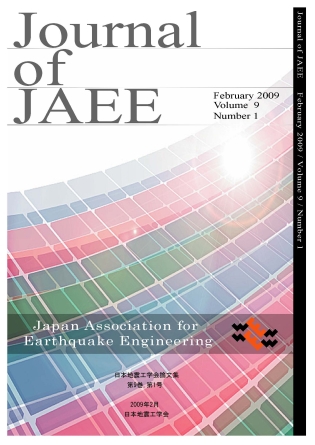
- Issue 6 Pages 6_1-
- Issue 5 Pages 5_1-
- Issue 4 Pages 4_1-
- Issue 3 Pages 3_1-
- Issue 2 Pages 2_1-
- Issue 1 Pages 1_1-
- |<
- <
- 1
- >
- >|
-
Masanobu TOHDO, Kensuke ARAI, Jun'ichi MIYAKOSHI, Toshiaki SATO, Hiroy ...2023 Volume 23 Issue 6 Pages 6_1-6_18
Published: 2023
Released on J-STAGE: December 28, 2023
JOURNAL FREE ACCESSWe re-examined the empirical scaling relationship between seismic moment M0 and short-period level A, which is the flat level of the acceleration source spectrum, adopted for setting asperity models of the inland crustal earthquakes in the "Recipe" for predicting strong ground motions published by the Headquarters for Earthquake Research Promotion (2020). Taking into consideration the scaling relationship between seismic moment and rupture area, which is defined as the three-stage model in the Recipe, an empirical equation was newly proposed as a three-fold-line model in which the short-period level was scaled with M01/3, M01/4, and M01/2 for each stage of the three-stage model. By comparing this new empirical equation with the data obtained from earthquake observation records, which included the area and stress drop of the strong motion generation area (SMGA), we found that the three-fold-line model for short-period level could match the short-period level data of SMGAs, and that the stress drop calculated from the empirical equation is independent of the seismic moment, which is consistent with the observational stress drop data of SMGAs.
View full abstractDownload PDF (2854K)
-
Katsuaki KONNO, Masami TOYODA2023 Volume 23 Issue 6 Pages 6_19-6_42
Published: 2023
Released on J-STAGE: December 28, 2023
JOURNAL FREE ACCESSLong-term structural health monitoring is conducted on the Toyosu campus of Shibaura Institute of Technology. The buildings are installed with accelerometer sensors and incorporated with base isolation devices, which are also installed in the ground. The fast Fourier transform (FFT) was used to analyze the microtremor records for nine years. The result shows a negative correlation between temperature and the natural period of the buildings, and the periods have increased by approximately 5% since the 2011 off the Pacific coast of Tohoku Earthquake. The auto-regressive exogenous (ARX) model was used to analyze the earthquake records. The result shows that the natural period and damping ratio of buildings are dependent on the amplitude of vibration. The periods have increased by 6%-10% due to the abovementioned earthquake, but the damping ratios have not changed.
View full abstractDownload PDF (9983K)
- |<
- <
- 1
- >
- >|